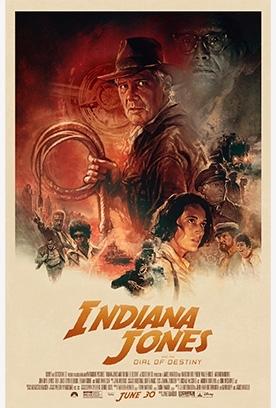‘Indiana Jones and the Dial of Destiny:’ If You Haven’t Looked at Ford Lately, Look Again
- Like
- Digg
- Del
- Tumblr
- VKontakte
- Buffer
- Love This
- Odnoklassniki
- Meneame
- Blogger
- Amazon
- Yahoo Mail
- Gmail
- AOL
- Newsvine
- HackerNews
- Evernote
- MySpace
- Mail.ru
- Viadeo
- Line
- Comments
- Yummly
- SMS
- Viber
- Telegram
- Subscribe
- Skype
- Facebook Messenger
- Kakao
- LiveJournal
- Yammer
- Edgar
- Fintel
- Mix
- Instapaper
- Copy Link

An inherent issue in producing a Hollywood franchise like Star Wars or the recent Guardians of the Galaxy III or even the broader family of Marvel action pics is the invitation to compare any one installment with its prequels (or in the case of Star Wars, I guess, its prequels and sequels.) Which is to say, no one film, at least in the eyes of a mass market craving “bigger and better,” can stand alone. Seems word got out before Indiana Jones and the Dial of Destiny opened that it wasn’t as good as the others. I’m not sure that’s fair (or anywhere near true,) but eager and loyal fans have every right to rush to judgment. And I’m not here to rank the five great Lucas-Spielberg “Saturday matinee cliffhangers.” But if you’ve not seen any of the others, this Indiana Jones will flatten your fedora as much as the first did (for me) in 1981. Wow! Was that really 42 years ago?
You wouldn’t know it by watching the first twenty-minutes of a nonstop, action-crammed Nazi train escape in which Indy and a pudgy cohort demolish most everything but the one archeological McGuffin––no, make that the second McGuffin––they rescue. Harrison Ford looks at least 25 years younger. It’s all rendered through CGI. (Not since Kurt Russell appeared forty-years younger than his actual 66 years in 2017’s GotG II have I been so puzzled and, ultimately, impressed.) And, yes, age is very relevant in this fifth installment of the Indy franchise.
Of Gods and Goddaughters
After his triumph in retrieving the coveted, “life-giving” Antikythera from the Nazis, Dr. Henry Walton “Indiana” Jones, Jr. (Harrison Ford) “awakens” 24 years later in his scuzzy, NYC one-bedroom. Professor Jones is about to retire. Grumpy as ever, he is estranged from his wife; their son Mutt killed in the Vietnam War. But, wait! Opportunity and new adventures knock in the guise of his goddaughter Helena (Phoebe Waller-Bridges) who is suddenly curious to learn “whatever might have happened to” that once coveted, ancient Greek mechanism Uncle Indy and her pudgy father rescued from that Nazi train. He reluctantly opens the caged door to his special collections to show her when… gunfire erupts outside. Grab your whip; here we go.
And go places, we do. From the French Alps to Sicily, from the blue Aegean Sea to Morocco’s narrow streets, director James Mangold flies us to remote locations, setting us up, cleverly, for the final and most spectacular destination ever. Mads Mikkelsen plays the deranged Nazi who re-appears as a still-mad NASA scientist. Toby Jones wonderfully plays the fumbling Oxford archeologist whose daughter, Helena, is played by Phoebe Waller-Bridge (she of “Fleabag” fame.) There is a brief cameo by Antonio Banderas as an expert frogman, and a return of John Rhys-Davies as Sallah who appears in two earlier Indy films. There may (and might not) be a few more actors associated with the franchise whose names I will not spill.
The Final Curtain
Fans in 1989 might have thought that Indiana Jones and the Last Crusade was produced to end the franchise which, despite its title, clearly did not. Indy’s father, played by Sean Connery, survives the story line, which begins with River Phoenix playing a young Indy, which all lends promise to a fourth outing, Indiana Jones and the Kingdom of the Crystal Skull. That most recent installment was in 2008, fifteen years ago. So what in the cinematic multiverse compels a studio to reengage a franchise that could have been left alone, comfortably locked in a vault of special collections, never to be disturbed, but idolized still for all the fun it brought so many years ago?
Hollywood bean counters and box office roulette aside, the answer has everything to do with Harrison Ford and his age. At 80 years old, never retired, soon to appear in a new Marvel re-mix (another Captain America,) and keeping his scarred scowl still relevant (and profitable) in an industry run by producers one-third his age, Ford embraces his Indy character to fulfill a destiny (aha!) worth more than any McGuffin might earn in the black market of archeological treasures. Yes, all the plot tropes are here––writhing snakes, booby-trapped caves, street-smart teens, femme fatales, sociopathic Nazis, animated treasure maps, WWII trains, planes and the most implausible escape vehicles––so every fan’s expectations are fulfilled with whip-smart ingenuity. But the destiny for which we take this sometimes sentimental but mostly rollicking ride means everything to the aged Indiana Jones. And, no, I won’t reveal what that is. In fact, to risk spoiling the last scenes of this last great franchise, there are really two. Let’s just say, the Dial of Destiny brings it all together.
Great Heroes Never Die
Could or would Indiana Jones and the Dial of Destiny stand alone without four prequels? Probably not. But the inside jokes, the frantic chase scenes, and the cleverly rewritten confrontations that ripple through each film like butter in a bucket of popcorn makes the experience no less rewarding than the first Raiders, or even before that, a long-ago Saturday matinee when Buck Rogers, Sinbad, or Tarzan saved the day. And none of them got to go where the immortal Indiana Jones goes this time out.
Dial this one up!
C. Prentiss Orr is a Pittsburgh-based writer who writes about theater and other topics for Entertainment Central. His latest book, The Surveyor and the Silversmith, is a history of white settlement, genocide, and land speculation in Western Pennsylvania.
Share on Social Media
- Like
- Digg
- Del
- Tumblr
- VKontakte
- Buffer
- Love This
- Odnoklassniki
- Meneame
- Blogger
- Amazon
- Yahoo Mail
- Gmail
- AOL
- Newsvine
- HackerNews
- Evernote
- MySpace
- Mail.ru
- Viadeo
- Line
- Comments
- Yummly
- SMS
- Viber
- Telegram
- Subscribe
- Skype
- Facebook Messenger
- Kakao
- LiveJournal
- Yammer
- Edgar
- Fintel
- Mix
- Instapaper
- Copy Link
Follow Entertainment Central
Sign up for the EC Newsletter
Latest Stories







